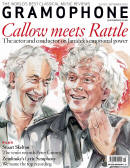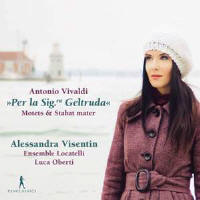Texte paru dans: / Appeared in: |
|
|
Outil de traduction (Très approximatif) |
|
|
Reviewer:
David Vickers Vivaldi’s motet Clarae stellae, scintillate (1715) was composed for Geltruda della Violetta (1684-1752), a talented musician in the coro of Venice’s all-female Ospedale della Pietà who played viola and theorbo, and was one of a small number of pupils who sang solo parts. It seems her alto voice was soft rather than loud, best heard in slow rather than virtuoso music, and that its compass was limited. Such characteristics are also evident in Filiae maestae Jerusalem and Non in pratis aut in hortis, both composed in about 1715 as introductions to a Miserere during Holy Week services at the Pietà’s chapel, so maybe they were also intended for Geltruda. The crisply shaded single strings, archlute and organ of Ensemble Pietro Antonio Locatelli provide spirited playing that duels for supremacy with the Venetian alto Alessandra Visentin (a pupil of Sara Mingardo). Clarae stellae, scintillate has theatrical verve and directness, albeit not as much sweetness and poeticism as the music potentially offers. Visentin’s emotive exaggeration of the opening and closing recitatives of Filiae maestae Jerusalem are besmirched by overly stretched tuning and jarring velocity, although in between them the Arcadian evocation of wafting breezes and rolling streams in ‘Sileant zephyri’ is aptly hushed (contoured mystery from overly literal strings would have been welcome). Extremely wide dynamic contrast between delicate pizzicato and strident bowing in the first stanza of Non in pratis aut in hortis is over-baked, but overlapping contrapuntal violins and Visenten’s sombre singing in the ensuing lament ‘Pro me caput spinas habet’ are finely judged. Conductor Luca Oberti claims tenuously that Geltruda might have performed the Stabat mater at the Pietà (it was commissioned by a church in Brescia). In any case, its inclusion here repeats a neat trick previously employed by The King’s Consort (Hyperion, 4/99) that the inconclusive final cadence of Non in pratis aut in hortis segues directly into the related key and mood of Stabat mater. This heartfelt interpretation is loaded with vivid contrasts and has a few momentary rough spots; doleful slow sections are performed with expressive sincerity and laudable finesse. Neither of Vivaldi’s ‘Santo Sepolcro’ works for strings and continuo were written for the Pietà either but they function as poignant interludes between motets. |
|




